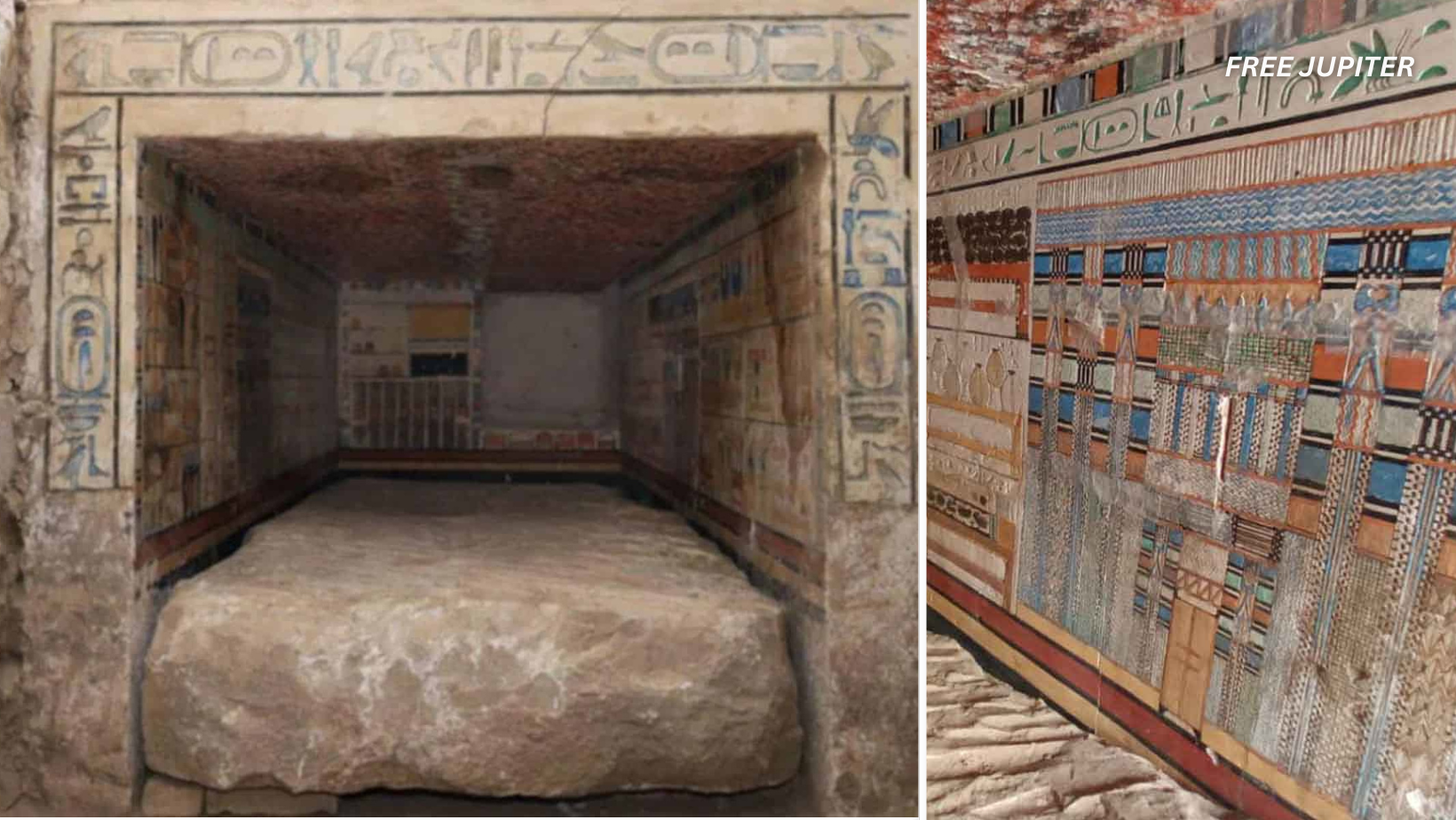Friendly Note: FreeJupiter.com shares general info for curious minds 🌟 Please fact-check all claims—and always check health matters with a professional 💙
Nestled within the sprawling Saqqara necropolis, just south of Cairo, a recent archaeological excavation has brought to light a tomb filled with extraordinary artifacts and architectural curiosities. Among these, a colossal pink granite door stands out-not only because of its impressive size but also due to its baffling nature: it leads to no chamber, no hidden room, no secret passage. This so-called “door to nowhere” has captured the imagination of scholars and enthusiasts alike.
The Door That Defies Expectations
The door measures over 14 feet tall and more than three feet wide. Crafted from pink granite, a material prized in ancient Egypt for its durability and symbolic significance, it is the largest and most elaborate false door ever discovered from this civilization. Unlike typical false doors, which were usually carved into limestone and modest in scale, this one dominates the tomb’s architecture with grandeur and precision.
False doors in ancient Egyptian tombs served as spiritual portals, believed to allow the deceased’s soul to pass between the earthly realm and the afterlife. They were often inscribed with the names and titles of the tomb’s occupant, accompanied by offerings and prayers. However, the sheer magnitude and choice of granite for this door suggest a special significance, perhaps reflecting the high status of the individual interred within.
This 4,300 Year Old Tomb Was Discovered In 1940 Now The Door To Its Eerie Remains Has Been Opened
Read more: Archaeologists Find an Ancient Temple Hidden in the Heart of a Cliff
The Tomb’s Distinguished Owner: Prince Waser-If-Re
This tomb belonged to Prince Waser-If-Re, a royal figure from Egypt’s Fifth Dynasty, approximately 4,000 years ago. He was the son of King Userkaf, the dynasty’s founder, which places him at a pivotal moment in Egypt’s Old Kingdom history. The inscriptions on the door enumerate his many roles: “Hereditary Prince,” “Royal Scribe,” “Vizier,” “Judge,” “Governor of Buto and Nekheb,” and “Chanting Priest.” These titles reveal a man of considerable influence, entrusted with both administrative and religious duties.
Adjacent to the main entrance, archaeologists uncovered a secondary doorway also fashioned from pink granite, bearing the cartouche of King Neferirkare, another prominent ruler of the Fifth Dynasty. This connection further underscores the tomb’s royal importance and the prince’s close ties to the ruling family.
A Chamber Brimming with Symbolism and Statues
Inside the tomb, the team unearthed thirteen high-backed chairs, each adorned with statues carved from the same pink granite as the door. These statues are believed to represent the prince’s wives, a testament to his status and familial connections. Interestingly, two of these figures were found headless, a detail that raises questions about possible ancient vandalism, ritual defacement, or damage over time.
The tomb also contained a black granite statue measuring over four feet in length, found toppled but remarkably well-preserved. This statue, along with a round red granite table approximately three feet in diameter, adds to the tomb’s rich collection of ritual objects. The table is inscribed with texts describing sacrificial rites, hinting at the ceremonial functions performed within or associated with the tomb.
A Site Reflecting Centuries of History
Though originally constructed during the Old Kingdom, evidence shows that the tomb was reused in later periods, most notably during the 26th Dynasty, roughly 2,500 years ago. Among the finds was a black granite statue of a standing male figure, also over four feet tall, bearing inscriptions linking it to this later era. This reuse illustrates how ancient Egyptians often repurposed burial sites, blending layers of history and cultural practices.
Royal Statues on the Move
Adding to the intrigue, archaeologists discovered statues of King Djoser-famed for commissioning Egypt’s first pyramid-his wife, and ten daughters. These statues were likely relocated from their original setting near Djoser’s pyramid to the tomb of Prince Waser-If-Re. The reasons behind this transfer remain unclear, but it suggests a complex history of tomb use, preservation, or political symbolism.
Read more: Newly Discovered Mummies From 7,000 Years Ago Don’t Share DNA With Modern Humans
Collaborative Efforts and Expert Insights
This excavation was a joint venture between Egypt’s Supreme Council of Antiquities and the Zahi Hawass Foundation for Archaeological and Heritage, combining decades of expertise and resources. Dr. Zahi Hawass, a renowned Egyptologist, emphasized the significance of the find, noting how each artifact enriches our understanding of ancient Egyptian culture, governance, and religious beliefs.
Saqqara: Egypt’s Eternal Burial Ground
Saqqara itself is a vast necropolis that served as the burial site for Memphis, the ancient capital of Egypt. Spanning thousands of years, it houses a diverse array of tombs, temples, and pyramids, including the famous Step Pyramid of Djoser. Recent discoveries in Saqqara have unveiled richly decorated tombs, intricate coffins, and a variety of artifacts spanning multiple dynasties, making it one of the most important archaeological sites in the world.
Artifacts Spanning Dynasties
The tomb’s contents reflect a broad historical spectrum. In addition to the granite statues and ritual furniture, archaeologists found pottery shards, amulets, and ostraca-pottery fragments used for writing or drawing. These items date from Egypt’s Second Dynasty through the Ptolemaic period, illustrating continuous use and reverence of the site over millennia.
Among the more unusual artifacts were terracotta statues of the goddess Isis and the child deity Harpocrates. Both figures held significant roles in Egyptian mythology, symbolizing protection, rebirth, and divine power. Their presence within the tomb suggests ongoing religious practices and the enduring importance of these deities.
Granite was a favored material for monuments and statues due to its strength and association with eternity. Its use in this tomb-especially for the false door and statues-reflects a desire to create lasting tributes that would endure beyond the mortal lifespan. The pink hue of the granite may also have held symbolic meaning, possibly linked to the sun or rebirth.
Questions Awaiting Answers
Despite the wealth of artifacts and inscriptions, many mysteries remain. Why was such an enormous false door constructed? What prompted the relocation of royal statues from their original resting places? Could the headless statues indicate ritualistic acts or later disturbances? These questions drive ongoing research and excavations at the site.
The Door’s Quirky Legacy
This monumental “door to nowhere” challenges our expectations of ancient architecture. Typically, doors serve as gateways, but here, the door is purely symbolic-a portal for the soul rather than a passage for the living. It stands as a testament to the Egyptians’ intricate beliefs about life, death, and the afterlife, inviting modern observers to reflect on the layers of meaning embedded in ancient art and architecture.
Read more: Beautiful Relics From Ancient Egypt Were Found In Hidden Chamber Down A 14-Meter Shaft
Continuing Exploration and Preservation
Archaeologists remain active at the site, carefully documenting and preserving the tomb’s contents. Their work not only sheds light on Egypt’s rich past but also ensures that these treasures endure for future generations to study and appreciate.
Conclusion: A Window into Ancient Egypt’s Soul
The discovery of Prince Waser-If-Re’s tomb, with its massive pink granite false door and array of statues and ritual objects, offers a fascinating glimpse into the spiritual and political life of ancient Egypt. It reminds us that behind every stone and inscription lies a story waiting to be told-a story of power, belief, artistry, and the enduring human quest to connect with what lies beyond.
As the sands of Saqqara continue to yield their secrets, this “door to nowhere” stands as a symbol of the mysteries that still captivate us, bridging the ancient world and our modern curiosity in a timeless dialogue.










